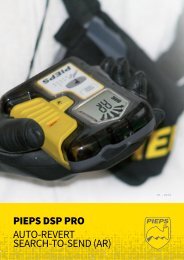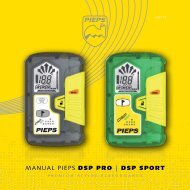LVS HintergrundwiSSen - pieps
LVS HintergrundwiSSen - pieps
LVS HintergrundwiSSen - pieps
Sie wollen auch ein ePaper? Erhöhen Sie die Reichweite Ihrer Titel.
YUMPU macht aus Druck-PDFs automatisch weboptimierte ePaper, die Google liebt.
The preferred size of a test field is 70x70m (no first signal at rescue start). To get a detailed result about the<br />
coherency of time for pinpointing and time for probing a smaller field has been used (30x30m, beacons already<br />
had a first signal). The typically used burial depth always has been about 1 meter and the “size of the target”<br />
has been defined with 40x60cm (in most cases simulated with blankets). As it’s completely up to the examinees,<br />
which beacon they are familiar with and which they want to use for their “final run“, a broad variety of<br />
available beacons had been used. In most cases, also data about 2nd and 3rd victims had been collected the<br />
same way.<br />
4. OBSERVED DATA<br />
From out the data of several test runs, done from<br />
2005-2007 we got the following general breakdown of<br />
separate steps during the beacon search:<br />
The first and astonishing result is, that the step “Pinpointing<br />
and Probing” together is roughly 58% from the total<br />
beacon search time!!<br />
And also the fact that roughly the same time is needed<br />
for “Pinpoiting” (45%) and “Rough Search” (42%)! To<br />
evaluate the coherency between “Pinpointing” and “Probing”<br />
with or without using the electronic iProbe, we<br />
made a special test series in Spring 2008 with a special<br />
focus on the time brake down for this individual steps.<br />
Only a larger number of different runs using different targets<br />
gave a representative result!<br />
Figure 3:<br />
Time brake down, data collected during final exams<br />
“Austrian Mountain Guide education”, 2005<br />
In this test series we had also volunteers with different skil<br />
levels (mountain guides, advanced users and amateurs).<br />
As can be seen from the data, little more time has been<br />
needed for pinpointing in comparison to data from field<br />
tests in 2005 (only professionals). Due to the mixed structure<br />
of test persons (we also had amateurs during this<br />
series) the time for probing is slightly higher.<br />
Figure 4: Test result, July 2008, „Dachstein Glacier”,<br />
time brake down of beacon search time,<br />
using standard probes<br />
After the first test series had been finished, a second series<br />
has been done with the same group of test persons,<br />
at same conditions but at a different test field, now using<br />
the iProbe with electronic target indication.<br />
A significant drop of both, the time for pinpointing and<br />
the time for probing is clearly given by these numbers.<br />
The average time for pinpointing dropped from 37 seconds<br />
down to 20 seconds (reduction of 46%) and average<br />
time for probing dropped down from 30 seconds to<br />
17 seconds (reduction of 44%)!!<br />
Figure 5: Test result, July 2008, „Dachstein Glacier”,<br />
time brake down of beacon search time,<br />
using PIEPS iProbe<br />
22<br />
PREMIUM ALPINE PERFORMANCE





